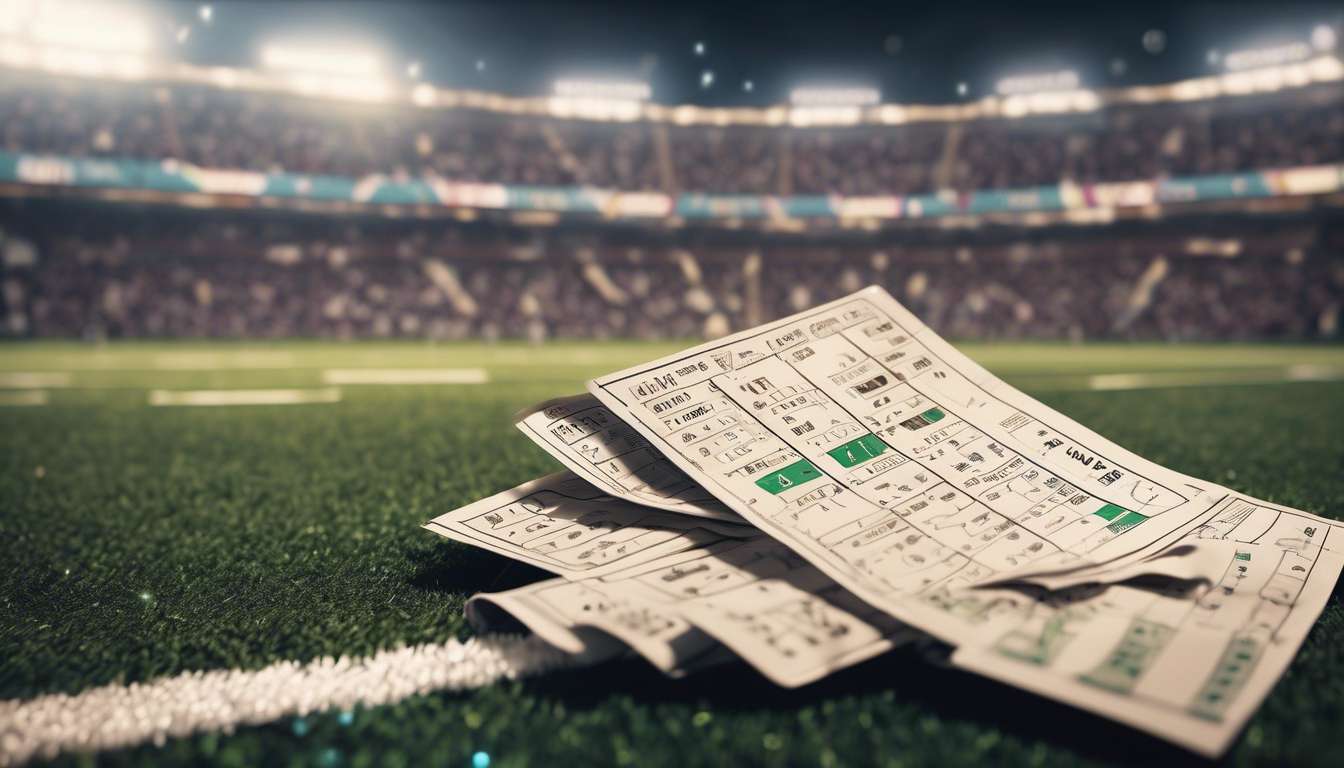As avid sports fans, we’ve all found ourselves swept up in the thrill of the game, eagerly anticipating the next big play or crucial decision. Yet, while many of us passionately follow our favorite teams and athletes, the intricacies of betting odds often remain a mystery.
Understanding these odds not only enhances our enjoyment of the sport but also sharpens our insight into the strategies at play. In this article, we delve into seven essential facts about betting odds that every fan should know.
Together, we will demystify the numbers and symbols that can often seem overwhelming, exploring how they influence the betting landscape and impact the outcomes we so fervently discuss.
By the end, we’ll be better equipped to appreciate the nuanced world of sports betting, transforming us from casual observers into informed enthusiasts ready to engage with the games we love on a whole new level.
Decimal vs. Fractional Odds
When comparing betting odds, we often encounter two main formats: decimal and fractional. These formats represent the same concept but in different ways.
Decimal Odds
- Prevalent among European bookmakers.
- Provide a straightforward way to calculate potential returns.
- Simply multiply your stake by the decimal figure to see your total payout.
- It’s easy to see how much you stand to gain.
Fractional Odds
- Commonly used in the UK.
- Express the ratio of the profit to the stake.
- For example, with odds of 5/1, you’d win five units for every unit wagered.
Understanding these formats helps us grasp the probability implied by the bookmakers, making us more informed participants in the betting community.
By embracing both formats, we increase our sense of belonging and confidence, whether we’re at the racetrack or cheering from the sidelines.
Implied Probability Explained
Understanding Implied Probability
Understanding implied probability allows us to see the underlying chance of an event occurring based on the odds given. It’s like unlocking a secret code that bookmakers have set. By grasping this concept, we’re not just passive spectators; we become part of an informed community that understands the game better.
Calculating Implied Probability
To calculate implied probability from odds, we need to translate those odds into a percentage.
For decimal odds, the formula is simple:
- Formula: (1 divided by the odds) multiplied by 100.
This gives us the probability the bookmakers have assigned to an outcome.
- Example: If the odds are 2.50, the implied probability is 40%. This means bookmakers believe there’s a 40% chance of that event occurring.
Comparing Probabilities
By understanding this, we can compare it to our own assessments.
- If our predicted probability is higher than the bookmakers’, there might be value in that bet.
Benefits of Understanding Implied Probability
Being part of this savvy group enhances our sense of belonging and makes the experience more thrilling.
The Role of Odds in Payouts
Understanding Odds in Betting
When we place a bet, odds determine not only the likelihood of winning but also the size of the payout. Understanding odds is key to maximizing potential rewards and navigating the exciting world of betting. Odds reflect the probability of an event occurring and help us gauge the risk we’re taking. By deciphering the odds, we can calculate our potential payout, allowing us to make informed decisions and feel more connected to the betting community.
Role of Bookmakers
Bookmakers play a critical role in setting these odds. They assess probability by analyzing a myriad of factors, including:
- Team performance
- Player statistics
This analysis ensures the odds are both fair and enticing.
Impact of Odds on Betting
- Higher odds: Indicate a lower probability of winning but promise a higher payout. This creates an alluring prospect for bettors.
- Understanding the balance: Grasping the balance between odds and payouts allows us to better position ourselves to enjoy the thrill of betting.
By understanding these dynamics, we can feel a sense of camaraderie with fellow fans and enhance our overall betting experience.
Understanding Plus and Minus Signs
One crucial aspect of betting odds is understanding the plus and minus signs, which indicate the underdog and favorite in a bet, respectively. As sports enthusiasts and betting fans, these symbols are more than just numbers; they represent the excitement and strategy of our shared passion.
The Plus Sign (+):
- Indicates the underdog in a bet.
- Tells us how much we could win on a $100 bet if the underdog triumphs.
- Highlights the potential reward, reflecting the probability that bookmakers assign to the less likely outcome.
The Minus Sign (-):
- Indicates the favorite in a bet.
- Shows how much we need to wager to win $100 on the favored team.
- Reflects the bookmakers’ assessment of a higher probability of success, indicating that the favorite has a stronger chance of winning.
By grasping these signs, we enhance our understanding of the odds and deepen our connection to the betting community. Together, we can make informed decisions, share insights, and celebrate victories.
Odds Formats Across the Globe
Across the globe, we encounter a variety of odds formats, each reflecting the unique betting culture and preferences of different regions. As fans eager to connect with others who share our passion, understanding these formats can enhance our experience and sense of belonging.
In the United States, bookmakers often use American odds, which show the amount we can win on a $100 bet.
In contrast, the UK and Ireland favor fractional odds, where the odds represent the ratio of winnings to the stake.
Meanwhile, decimal odds dominate in Europe and Australia, offering a straightforward way to see our potential returns, including the stake.
Each format carries its own charm and simplifies the calculation of probability in its own way. By familiarizing ourselves with these formats, we can seamlessly engage with fellow fans and bookmakers around the world, deepening our appreciation for the global betting community.
Let’s embrace these odds formats as part of our shared journey in the world of sports betting.
How Bookmakers Set Odds
Understanding how bookmakers set odds is crucial to grasping the dynamics of sports betting. As a community of sports enthusiasts, we should delve into the fascinating process bookmakers use to determine these odds.
Core Concepts in Setting Odds:
- At its core, setting odds involves assessing the probability of various outcomes in a sporting event.
- Bookmakers rely on a mix of:
- Statistical data
- Expert analysis
- Historical performance
Adjusting Odds for Profitability:
- To make betting appealing and profitable, bookmakers adjust the odds to reflect the perceived likelihood of each outcome.
- They incorporate a margin, known as the “vig” or “overround,” ensuring profitability regardless of the event’s result.
- This margin subtly shifts the odds, creating a cushion against potential losses.
Market Dynamics and Strategic Decisions:
- The odds reflect not only probability but also market dynamics.
- Bookmakers constantly balance their books, so the odds we see are a reflection of:
- Calculated probabilities
- Strategic business decisions
As we engage with this shared interest, it’s essential to understand these factors to better navigate the world of sports betting.
Factors Influencing Odds Changes
Several key factors can cause odds to change dynamically in the sports betting landscape.
One major influence is the amount of money wagered on a particular outcome. When there is a surge in bets on one side, bookmakers may adjust the odds to balance their books and minimize risk. They’re always looking to keep the probability in their favor.
Injuries and team news are also pivotal. If a star player is suddenly out, the probability of that team winning decreases, prompting bookmakers to adjust the odds accordingly.
Weather conditions can affect outdoor sports as well. For instance, a rainy forecast might alter the odds in a football match.
Public sentiment and media coverage play crucial roles in the dynamics of odds.
- If a team receives heavy media attention, it could sway public opinion.
- This leads to changes in betting patterns and thus the odds.
Bookmakers are adept at reading these trends and adjusting odds to reflect the shifting probabilities.
By understanding these factors, we can better navigate the odds landscape.
Avoiding Common Betting Pitfalls
Let’s dive into some common betting pitfalls we should all be aware of to make more informed decisions.
Understanding the Odds:
- One major pitfall is not understanding the odds. Odds aren’t just numbers; they represent the probability of an event occurring.
- When we grasp this, we can assess whether a bet offers good value.
- Bookmakers set the odds and aim to make a profit regardless of the outcome. It’s crucial to remember that the odds are often skewed in their favor.
Chasing Losses:
- Another pitfall is chasing losses. It’s easy to get caught up in the moment, thinking we can recover what we’ve lost.
- This mindset can lead us to make impulsive decisions, ignoring the actual probability of winning.
- Instead, we should:
- Set a budget.
- Stick to it.
- Accept losses as part of the game.
Betting on Favorite Teams:
- Additionally, placing bets on our favorite teams without considering the odds or probability can cloud our judgment.
- Let’s strive to bet objectively, keeping emotions in check.
By being aware of these pitfalls, we can make more rational and informed betting decisions.
How do betting odds differ between sports like football, basketball, and horse racing?
Betting Odds Variations Across Sports
Betting odds vary across sports like football, basketball, and horse racing due to differences in gameplay, player performance, and event outcomes.
Football:
- Odds may be influenced by team rankings.
- Recent team form plays a crucial role.
Basketball:
- Factors impacting odds include player injuries.
- Head-to-head matchups are significant.
Horse Racing:
- Odds are based on the horse’s past performance.
- The jockey and track conditions are critical factors.
Conclusion:
Understanding these differences can help us make informed betting decisions.
What are some historical origins of betting odds and how have they evolved over time?
Betting Odds: A Historical Overview
Betting odds have a fascinating history that dates back centuries. They originated as a way to facilitate fair wagers among individuals.
Evolution and Standardization
Over time, odds have evolved to become more standardized and accessible. This evolution has been significantly influenced by the rise of online betting platforms, which have made it easier for people to participate in betting from anywhere in the world.
Historical Origins and Modern Development
Understanding the historical origins of betting odds provides valuable insights into the development of modern betting practices. It’s interesting to see how this aspect of sports betting has changed and adapted over the years, reflecting broader changes in society and technology.
Key Changes Over Time
- Standardization: Initial informal systems have evolved into more formalized odds structures.
- Accessibility: Online platforms have democratized access to betting, making it more prevalent.
By studying these changes, one can appreciate the complexities and advancements in the field of betting odds.
Are there any cultural or regional preferences for certain types of odds formats?
Yes, there are indeed cultural and regional preferences for different types of odds formats in the world of sports betting.
Fractional Odds:
- Commonly used in the UK and Ireland.
- Presented as fractions, for example, 5/1.
Decimal Odds:
- Preferred in Europe, Canada, and Australia.
- Expressed in decimal format, such as 6.00.
American Odds:
- Popular in the United States.
- Shown as positive or negative numbers, like +500 or -200.
Understanding these preferences can help us connect better with fans from various backgrounds and engage in meaningful conversations about sports betting.
It’s important to respect and appreciate the diversity of perspectives when it comes to odds formats.
Conclusion
Understanding Betting Odds
Now that you’ve grasped the essential facts about betting odds, you’re well-equipped to navigate the world of sports betting with confidence. Here’s a breakdown of the key concepts:
Types of Odds
- Decimal Odds: These are expressed as a single number, representing the total payout for a winning bet, including the original stake.
- Fractional Odds: Common in the UK, these odds show the ratio of the profit to the stake.
Implied Probabilities
Understanding the conversion of odds into implied probabilities is crucial for assessing the likelihood of an event and determining value bets.
Role of Odds in Payouts
Odds directly influence the payout you receive from a winning bet, with higher odds offering larger payouts.
Factors Influencing Odds Changes
- Team/player performance
- Injuries
- Weather conditions
- Betting market activity
Avoiding Common Pitfalls
- Don’t bet with emotion; remain analytical.
- Avoid chasing losses.
- Be aware of the bookmaker’s margin.
Conclusion
With this knowledge, you’re ready to make informed betting decisions and enjoy the thrill of wagering on your favorite sports.
Happy betting!




